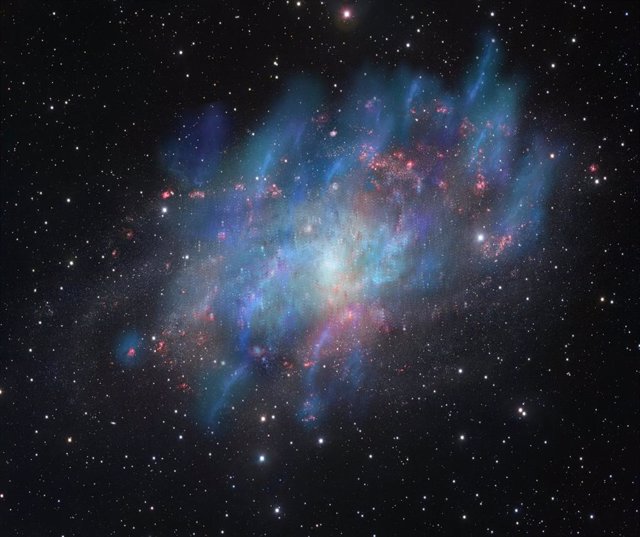Artist’s illustration of cosmic ray-driven winds (blue and green) superimposed on a visible-light image of the Triangulum galaxy M33 (red and white) observed with the VLT Survey Telescope at ESO’s Paranal Observatory in Chile. – INSTITUTE FOR RESEARCH IN FUNDAMENTAL SCIENCES/ESO
Oct. 25 () –
Observations with the Karl G. Jansky Very Large Array (VLA) telescope have discovered a Important new clue about how galaxies curb vigorous episodes of star formation.
Their new study of neighboring galaxy M33, 2.7 million light-years away, indicates that fast-moving cosmic-ray electrons they can drive winds that carry the gas needed to form new stars.
Such winds are responsible for slowing the rate of star formation as galaxies evolve over time. However, shock waves from supernova explosions and energetic jets of material fueled by black holes from galactic nuclei have been considered the main drivers of those winds. Cosmic rays were thought to be minor contributors, particularly in galaxies like M33 that have regions of prolific star formation.
“We have seen cosmic ray-driven galactic winds in our own Milky Way and the Andromeda galaxy, which have much weaker star formation rates, but not before in a galaxy like M33,” he said. it’s a statement Fatemah Tabatabaei, from the Research Institute of Fundamental Sciences in Iran.
Tabatabaei and an international team of scientists conducted detailed multiwavelength VLA observations of M33, a spiral galaxy nearly 3 million light-years away. and part of the local group of galaxies that includes the Milky Way. They also used data from previous observations with the VLA, the Effelsberg radio telescope in Germany, and millimeter-wave, visible-light, and infrared telescopes.
Stars much more massive than our sun speed through their life cycles, eventually exploding as supernovae. Explosive shock waves can accelerate particles to nearly the speed of light, creating cosmic rays. A sufficient number of these cosmic rays it can generate pressure that drives winds and carries away the gas needed to continue forming stars.
“The VLA observations indicated that cosmic rays in M33 are escaping from their birth regions, allowing them to drive more extensive winds,” said William Cotton of the National Radio Astronomy Observatory (NRAO).
Based on their observations, the astronomers concluded that the numerous supernova explosions and supernova remnants in the prolific star-forming giant complexes of M33 they made such cosmic ray-driven winds more likely.
“This means that cosmic rays are likely to be a more general cause of galactic winds, particularly earlier in the universe’s history when star formation was occurring at a much higher rate,” Tabatabaei said. He added that “this mechanism thus becomes a more important factor in understanding the evolution of galaxies over time.”
Tabatabaei, Cotton, and colleagues report their findings in Monthly Notices of the Royal Astronomical Society.

![[Img #74818]](https://thelatestnews.world/wp-content/uploads/2025/01/Betiton-Casino-innovation-and-online-gaming-technology-for-a-unique-150x150.jpg)









![[Img #74818]](https://thelatestnews.world/wp-content/uploads/2025/01/Betiton-Casino-innovation-and-online-gaming-technology-for-a-unique-300x200.jpg)
